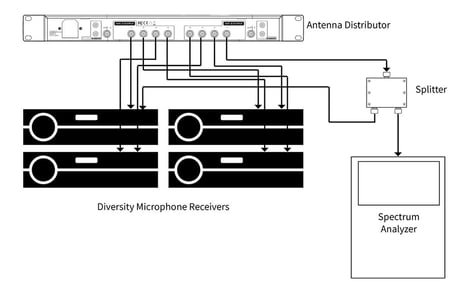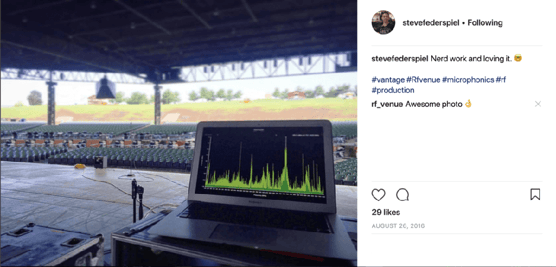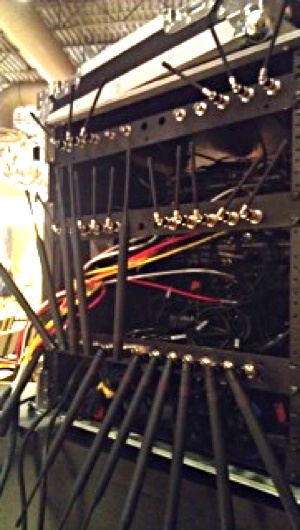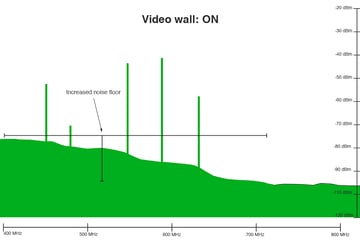- Products
- All Products
- RF PA Extension Kit
- Wireless Microphone Upgrade Packs
- In-Ear Monitor Upgrade Packs
- Wireless Microphone Antennas
- Wireless In-Ear Monitor Antennas
- Antenna Distribution for Microphones
- Antenna Combiners for In-Ear Monitors
- Multi-Zone Antenna Combiners
- Spectrum Tools
- Accessories, Cables and Parts
- Solutions by Venue
- Resources & Training
- Performance Tools
- About Us

Simple tips to keep your wireless microphones on the air
I had one of our dealers tell me at the recent InfoComm show that he had saved his customer $20,000 by simply correcting a less than stellar installation and adding some RF Venue gear instead of replacing the entire system. As it turned out, the existing wireless mics were fine but there was an antenna farm instead of a proper antenna distribution system. So the simple addition of a Distro4 and a Diversity Fin antenna got the system back up and running - dropout free - for a fraction of the cost of a full system replacement.
One of our most popular blogs ever was “The top three wireless microphone problems and how to solve them”. All good advice if you have never had a chance to read this one. These are indeed the most frequent causes of less than reliable performance, but how are they related to system design and setup?
I’d like to take the time to expand on this and point out some real world examples. If you haven’t already heard from a customer for whom you installed a wireless system in the past that is now having problems, I expect with the new set of challenges coming your way from spectrum reassignment, T-mobile and Microsoft intrusions and the greater acceptance of LED lighting you will be soon. The Top Three Problems blog listed the following:
1. Signal Dropouts and Multi-path interference
2. Noise Floor and Interference
3. Intermod distortion and frequency coordination
Out in the real world it is very likely that one or more of these problems are acting together to push you past the threshold of reliable and dropout-free performance. There are usually a lot of little factors knocking you off the air. It could be that no single issue is the culprit, but several acting together and you're done.
Improving your situation might be as simple as re-aiming or adjusting your antenna position. Are you maintaining direct line of sight between mic transmitters and receive antennas? Does your antenna cover the geometry of the performance area? Are your antennas above head height or are they fixed to receivers in a rack on on a desk? Just getting them up in the air above head height can make a big difference. If you have a spectrum analyzer to tap into your system and measure signal levels, you might be able to make a 20 dB improvement in the signal. Just move your receiving antenna around a bit and watch the results on the analyzer screen.


As the signal from your microphone transmitter makes its way to your receiver it will inevitably bounce off all kinds of surfaces in the venue in a similar fashion to the TV ghost problems we often experienced back in the days of analog television. In a typical live performance venue or sanctuary, our patented Diversity Fin antenna is usually a plug and play solution to this problem as it minimizes multi-path issues while statistically eliminating cross-fade polarization. If your system is still using the factory supplied whip antennas you’ll want to be sure they are 6 feet away from any walls or other boundaries.
 Speaking of factory whips … do you have an antenna farm? It may have worked in the past, even though they are very inefficient. In the current RF spectrum landscape, where more devices competing for less spectrum, if you have 4 or more receivers you really need to have an antenna distribution system. Receiver antennas should never be closer than 6” and much better if they are two feet apart. That makes for a pretty wide spread across your mixing desk and is nearly impossible in an equipment rack without using a distro. Antennas in close proximity actually steal power from each other and usually unintentionally form an array which makes their patterns unreliable.
Speaking of factory whips … do you have an antenna farm? It may have worked in the past, even though they are very inefficient. In the current RF spectrum landscape, where more devices competing for less spectrum, if you have 4 or more receivers you really need to have an antenna distribution system. Receiver antennas should never be closer than 6” and much better if they are two feet apart. That makes for a pretty wide spread across your mixing desk and is nearly impossible in an equipment rack without using a distro. Antennas in close proximity actually steal power from each other and usually unintentionally form an array which makes their patterns unreliable.
Almost everything has a microprocessor in it these days, and these devices can create RF noise that bleed into your wireless audio system. You’ll want to use caution when mounting any digital gear in the rack with your receivers. The best solution here again is to use a distro and remote the antennas to a desirable location to avoid RF interference.
How about your coax? If you have any exposed coax or any that are rolled up after use you should consider them suspect. Coiling them can degrade performance. Just like every time you drive around the block and wear your tires a bit same thing happens to your coax. You get less and less performance. Unfortunately it take a very expensive test rig to accurately test your cables. A multi meter only checks for DC continuity but tells you nothing about ac flowing at 500 MHz. Plan on regularly replacing them. And these days with the advent of digital wireless systems we would highly recommend using a double shielded coax like our RG8x or Belden 9913 to LMR400 for runs over 100 feet (or our Optix if over 200 feet).
Minimizing intermod problems may be as simple as getting great frequency coordination from programs such as Wireless Workbench (free from Shure). However if you use a receiver to gather the data remember that your receiver can only see its dedicated frequency range so you are measuring with blinders on. We recommend using a scanner and gathering data at least 50 MHz or either side of the frequencies you intend to use. That way the program can consider interference from out of band sources (such as LED lighting or the new T-Mobile 600MHz sources). Both of these can create intermod that can contribute significantly to the noise floor. In this manner you will likely get a much more refined channel list from the software. If you missed any of our blogs on bandpass filtering please take a look as they can easily reduce your noise floor from such interference by 10 dB or better.
Hopefully using some of these ideas can save you headaches (and money!) as wireless audio deployments get trickier.
For more tips and tricks be sure to checkout our free Three Essential Concepts for Wireless Audio at the link below. And as always, if you need help on feedback on a project feel free to Contact Us Here.
Tag(s):
Don Boomer
Don Boomer is Senior applications engineer at RF Venue. He has worked in R&D in the past for Peavey, Sabine and Line 6 and his rock band from his high school days has a song in the Rock n Roll Hall of Fame
More from the blog
Subscribe to email updates
Stay up-to-date on what's happening at this blog and get additional content about the benefits of subscribing.




